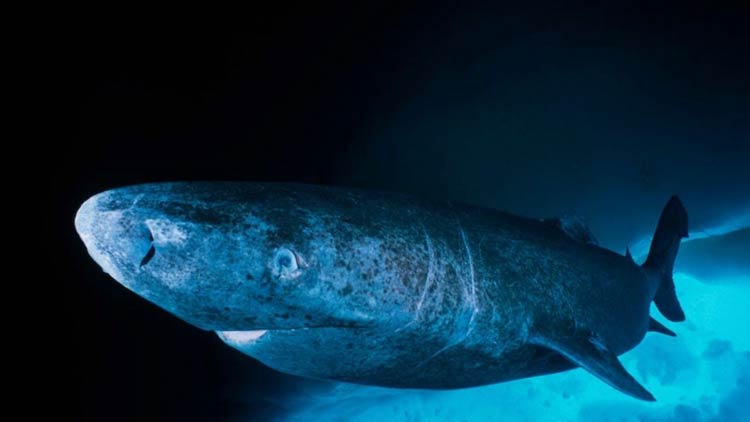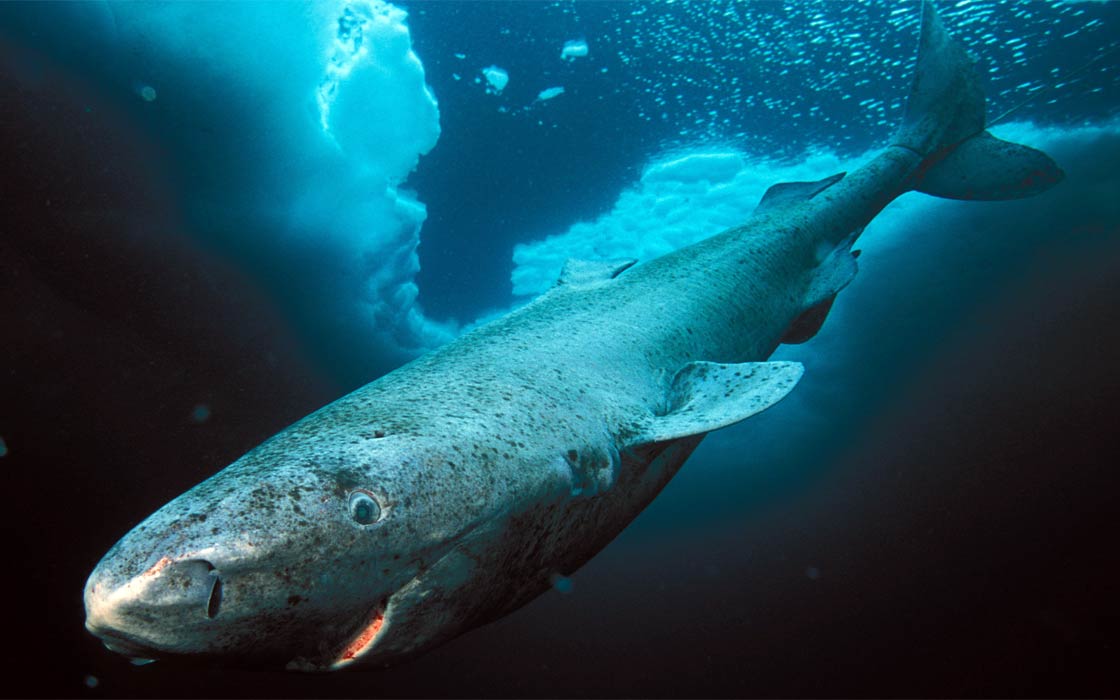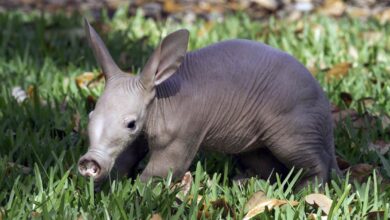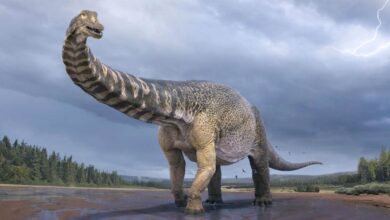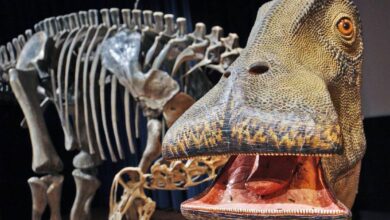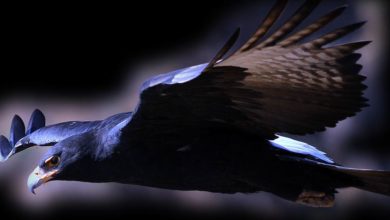Greenland shark, gurry shark, grey shark (Somniosus microcephalus)
The Longest-Living Vertebrate
It is said that the human body is programmed to live for 120 years. To most of us, this seems almost impossible. However, 120 years for a human is little compared to the capabilities of other living organisms on Earth. Fish, turtles, or marine mammals can live longer than us. There’s probably no need to mention sponges (Scolymastra joubini) living for 15,000 years or the immortal jellyfish.
To this group, we can now add a true record-holder among vertebrates – the Greenland shark, which is the subject of the article below. Let’s explore the story of arguably the longest-living vertebrate in the world and one of the slowest sharks.
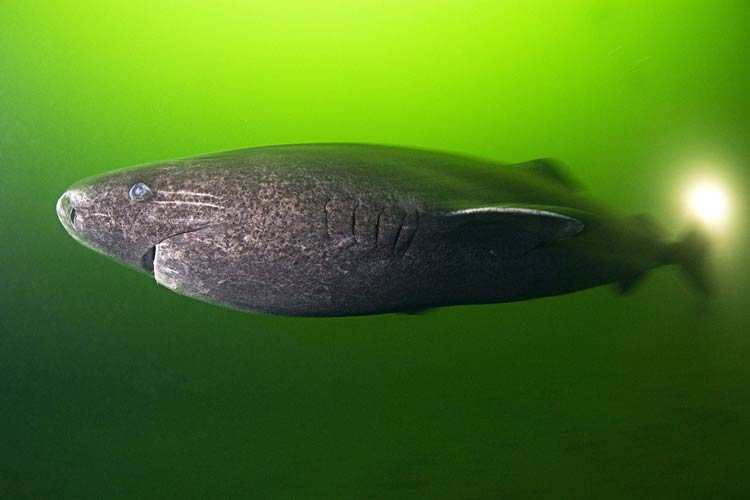
Classification
- Kingdom: Animalia
- Phylum: Chordata
- Class: Chondrichthyes (cartilaginous fishes)
- Subclass: Elasmobranchii
- Order: Squaliformes
- Family: Somniosidae
- Genus: Somniosus
- Species: Somniosus microcephalus
- Names: Greenland shark, gurry shark, grey shark
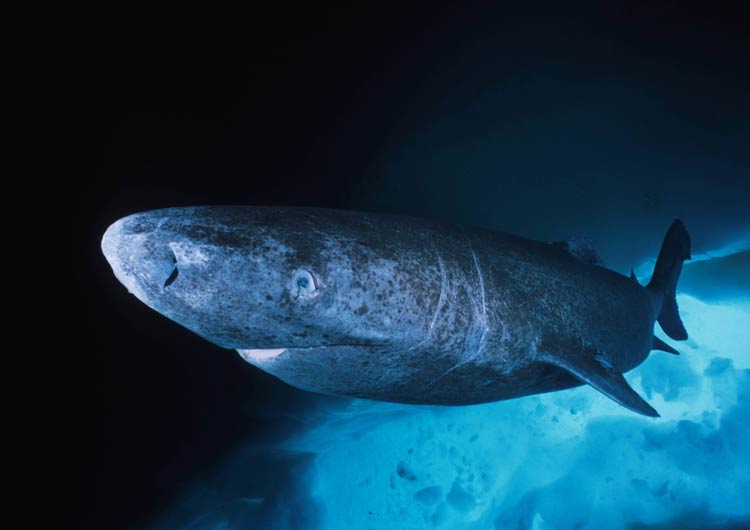
Occurrence
The Greenland shark can be found in the northern regions of the Atlantic Ocean, the White Sea, and the Arctic Ocean. Its body is adapted to deep-water environments, a capability it readily utilizes. Sharks of this species have been encountered at depths of 2,200 meters (7,218 feet), although they typically swim somewhat shallower, around 1,200 meters (3,937 feet).
In August 2013, scientists from Florida State University captured the first documented Greenland shark in the Gulf of Mexico. The fish was swimming at a depth of 1,749 meters (5,738 feet), where the water temperature was 4.1°C (39.4°F).
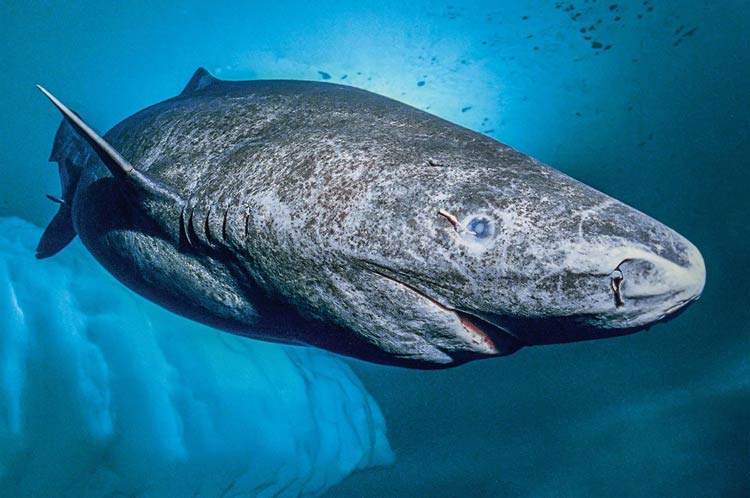
Characteristics
It is characterized by a short, rounded snout, small eyes, and very small pectoral and dorsal fins. The gill slits also appear disproportionately small compared to the animal’s size. Its skin is creamy-gray or blackish-brown. The colors usually blend into a uniform mass, but some sharks may also have white spots or dark streaks.
The teeth in the upper jaw are very thin and pointed. They act like an anchor, grasping prey into the mouth. The teeth in the lower jaw are wide, square, and nodular, and their main function is to portion food.
It competes with its cousin, Pacific sleeper shark (Somniosus pacificus), for the title of the largest member of the family Somniosidae. It is also considered one of the largest living sharks. Only slightly smaller than the great white shark (Carcharodon carcharias), it reaches 2.4-4.8 meters (7.9-15.7 feet) in length and weighs 400 kg (882 pounds). The largest recorded specimens can measure over 6 meters (19.7 feet) in length and weigh over 1 ton (2,205 pounds). Males are typically smaller than females.
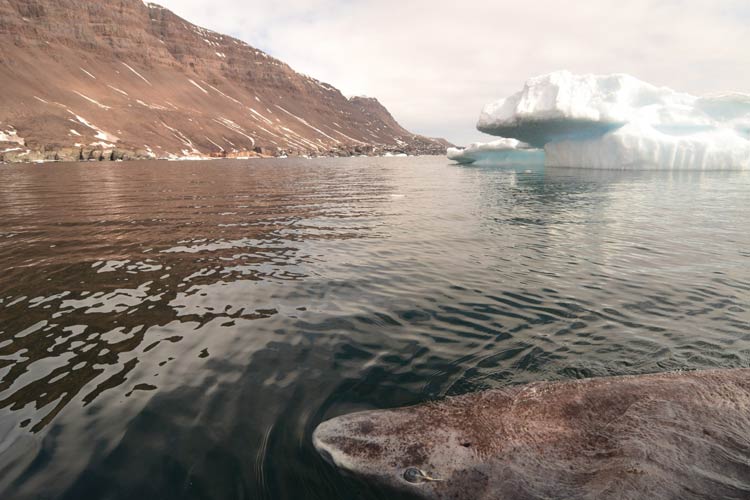
Diet
As an apex predator, it can hunt almost any fish. It preys on smaller sharks, skates (Rajiformes), eels, herring, flounders, wolfishes, and also marine mammals the size of a seal. Remains of polar bears, moose, reindeer, and horses have also been found in its stomach. It’s considered a scavenger with a keen sense of smell for rotting meat. Greenland sharks often gather around fishing boats, drawn by the strong scent of fish emanating from the deck.
Lifestyle
The Greenland shark swims slowly and steadily. It moves at approximately 1 km/h (0.6 mph), accelerating to just over 2.5 km/h (1.6 mph). This makes it one of the slowest-swimming sharks. Its maximum speed is half that of an average seal. So, how does the Greenland shark hunt prey that is faster than itself? Scientists suspect that it attacks prey while they are sleeping.
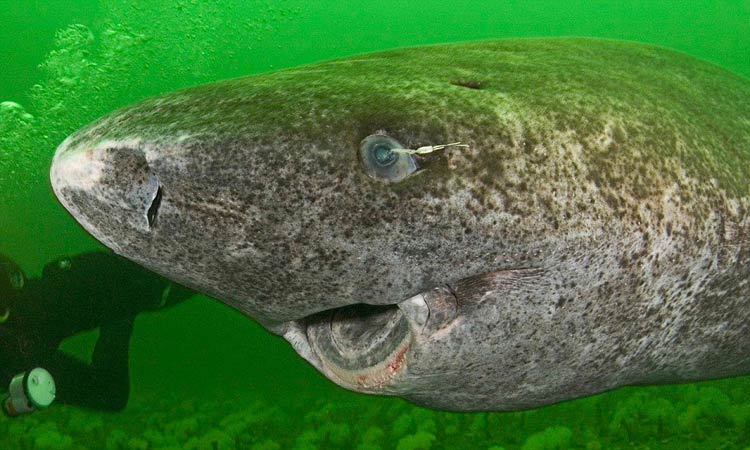
Once Upon a Time… A Few Words on Longevity
Until now, the bowhead whale (Balaena mysticetus) was thought to be the longest-living vertebrate in the world. Its longevity cannot be denied – it lives for over 200 years. However, there’s strong evidence suggesting that the Greenland shark lives 200 years longer.
The question of deep-sea animal longevity was raised by biologists in the 1930s. Based on observations of 400 tagged sharks, they concluded that these sharks grew only 1 cm (0.4 inches) per year. Considering that Greenland sharks grow up to 6 meters (19.7 feet) in length, it was assumed they must live for a very long time to reach their size.
However, the exact duration of this lifespan was never determined. Fortunately, by using radiocarbon dating methods, we are closer to discovering the true age of these sharks (a topic we previously covered in the article: “Sharks – Myths and Facts”). In this way, in 2016, it was calculated that Greenland sharks live for a minimum of 120 years, while their maximum lifespan could be as long as 512 years (392 ± 120). If these calculations are correct, it would also mean that sexual maturity is only reached at around 150 years of age.
Scientists also attempted to calculate the age of Greenland sharks based on characteristic calcifications on their pectoral fins, which function similarly to tree rings. However, this method doesn’t work for our subjects, as these hard bony structures are not present in them. The most reliable method for calculating an individual’s age is simultaneously not very subtle and morally questionable.
To determine a shark’s age, one must extract its eye lenses. These lenses record certain information, and their inactive parts are cyclically replaced with new ones. By detaching a layer of the lens, researchers can reach an element that “remembers” the early life stage. Based on this element, the age of the examined animal is determined.
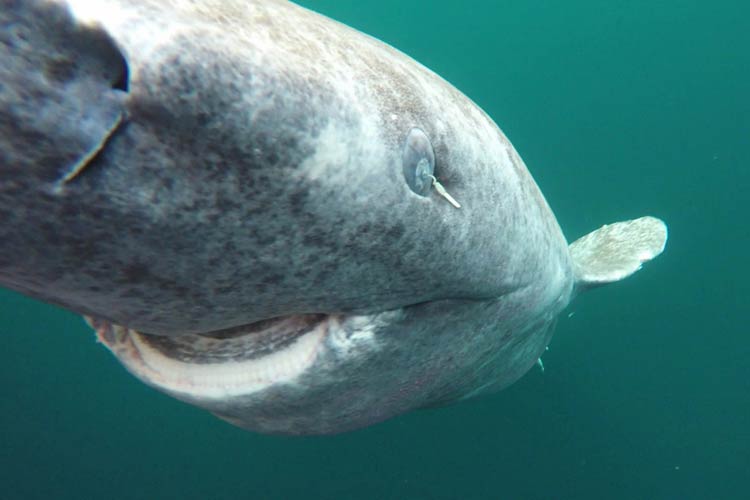
Eye Predation
In many photos, parasites can be observed attached to the eyes of Greenland sharks. Observations indicate that most of them host these parasites. These parasites are copepods (Copepoda), specifically Ommatokoita elongata, which consume their corneas, consequently leading to impaired vision or complete blindness. These parasites typically reach about 3 cm (1.2 inches) in length, and it’s the females that attach to the shark’s eyes. Interestingly, sharks completely free of these parasites are a rarity.
A Deep-Sea Demon…
Because these copepods glow in the dark, the Greenland shark takes on a demonic appearance when its eyes emit a greenish glow in the ocean depths. This also has a beneficial side – small fish and other marine creatures, attracted by the glow, become the shark’s meal.
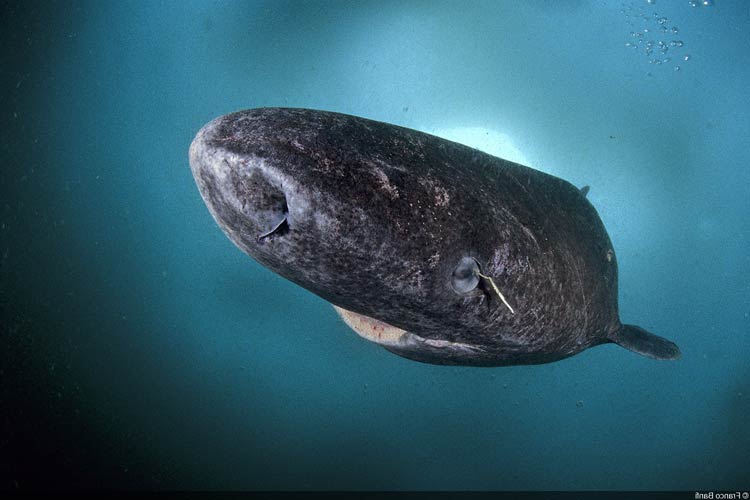
Detailed Data / Dimensions
Greenland shark (Somniosus microcephalus)
- Body length:
- average 2.4-4.8 m (7.9-15.7 ft)
- maximum known 6.4 m (21 ft)
- maximum probable 7.3 m (24 ft)
- Weight:
- average 400 kg (882 lb)
- maximum known 1,000 kg (2,205 lb)
- maximum probable 1,400 kg (3,086 lb)
- Lifespan: 392 ± 120 (272 – 512) years
- Sexual maturity: at about 150 years of age
- Estimated gestation period: 8 to 18 years
- Diving depth: up to 2,200 m (7,218 ft)
- Preferred temperature: -0.6 to 12 °C (30.9 to 53.6 °F)
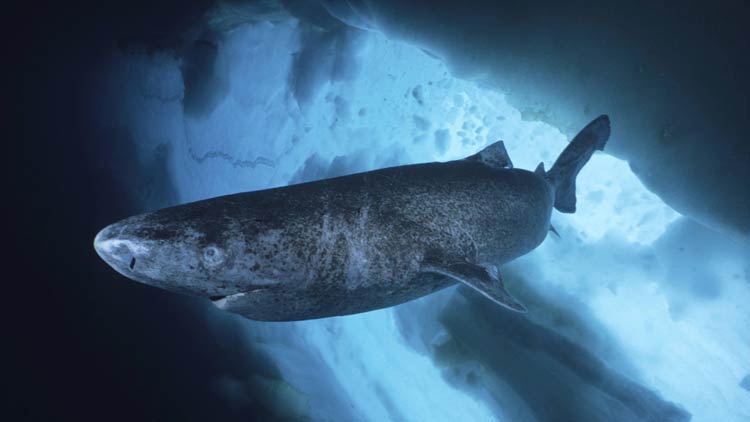
Greenland Shark – Interesting Facts
- The tissues of the Greenland shark contain a high concentration of an organic compound called TMAO (trimethylamine N-oxide). This compound makes the meat toxic. However, this doesn’t deter Icelandic chefs. In Iceland, there’s a delicacy called Kæstur hákarl – shark meat that undergoes a special curing process aimed at reducing the amount of toxin present.
- In Icelandic, Kæstur hákarl can be translated as “cured shark.”
- Ancient Eyesight (and lack thereof): the copepod parasite Ommatokoita elongata is causing blindness, but it’s worth noting that even if the sharks weren’t affected by these parasites, their eyesight is naturally very poor. Their eyes are primarily adapted for detecting light and shadow in the dark, deep waters where they live, rather than for sharp vision.
- Unique Anti-Freeze: To survive in their frigid, deep-water habitat, Greenland sharks have high concentrations of urea and trimethylamine N-oxide (TMAO) in their tissues. These compounds act as natural antifreeze, preventing ice crystals from forming in their bodies and allowing them to withstand temperatures below freezing. The TMAO, as mentioned, is also what makes their meat toxic without proper preparation.
- Slow-Motion Hunters: It’s truly remarkable how a large predator can sustain itself with such a low metabolic rate and hunting strategy, perfectly suited to the energy-scarce deep-sea environment. Their slow growth and extreme longevity are direct consequences of this low metabolic rate.
- No Swim Bladder: Like other sharks, Greenland sharks lack a swim bladder. Instead, they rely on a large, oily liver for buoyancy control, which helps them maintain their position in the water column without expending too much energy.
